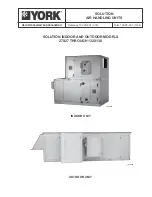
24
PRE-START CHECKLIST
Is unit properly located, level, secure and service-
able?
Has auxiliary pan been provided under the unit with
separate drain? (Units installed above a finished
ceiling).
Is condensate line properly sized, run, trapped,
pitched and tested?
Is ductwork correctly sized, run, taped and insu-
lated?
Have all cabinet openings and wiring been sealed
with caulking?
Is the filter clean, in place and of adequate size?
Is the wiring tight, correct and to the wiring diagram?
Is the unit properly grounded and protected (fused)?
Is the thermostat heat anticipator been set properly?
Is the unit circuit breaker(s) rotated properly “on” up
- “off” down?
Are the unit circuit breaker(s) line lug cover(s) in
place?
Are all access panels in place and secure?
s
YES
s
NO
s
YES
s
NO
s
YES
s
NO
s
YES
s
NO
s
YES
s
NO
s
YES
s
NO
s
YES
s
NO
s
YES
s
NO
s
YES
s
NO
s
YES
s
NO
s
YES
s
NO
s
YES
s
NO
Refer to outdoor unit installation instructions for system
start-up instructions and refrigerant charging instructions.
4.0 START-UP
4.1 PRE-START CHECKLIST
4.2 SYSTEM START-UP AND OPERATIONAL CHECK-OUT
After the air-handler and other system components have been installed and the Pre-
Start Checklist has been completed, the system should be started up and an operational
check-out should be performed. The operational check-out includes checking sequence of
operation of the controls, air-flow, and refrigerant charge. If the controls are not found to be
functioning properly, or the air-flow or refrigerant charge are not within specifications, cor-
rective action must be taken. The following sections are provided to assist the installer with
the operational check-out.
4.3 SEQUENCE OF OPERATION
4.3.1 COOLING MODE
When the thermostat calls for cooling, the G terminal on the blower control board is
energized which in turn energizes the indoor blower motor. This causes the indoor blow-
er to circulate air through the air-handler and duct system during the cooling cycle. For
(-)F1T air-handlers, the Y terminal on the blower control board is also energized which
tells the blower control board to energize the cooling speed on the motor instead of the
reduced CFM continuous fan speed.
When the thermostat call is satisfied or the thermostat is turned to the off position. The
G and Y terminals on the blower control board are de-energized. A time delay pro-
grammed into the (-)F1P blower control board or (-)F1T motor keeps the blower motor
energized for an additional 30 seconds to extract the residual cooling from the cold
indoor coil.
4.3.2 ELECTRIC HEAT MODE
When the thermostat calls for the 1st stage of heat, the W1 terminal on the blower con-
trol board is energized. This energizes the indoor blower motor and all of the electric
heater elements for heater kits with 10kW of heat or less and the 1st stage elements for
13kW heater kits and higher. If W1 and W2 thermostat pigtails at the air-handler are
wired together on 13kW heater kits and higher, all of the elements to be energized. For














































